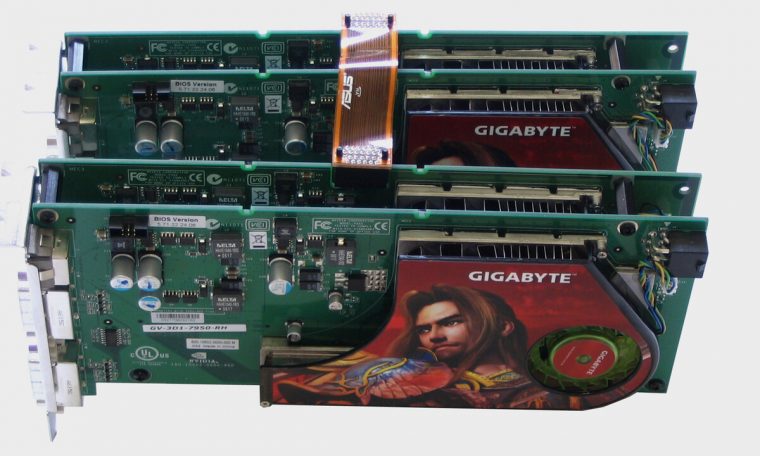
Nvidia already offered dual-GPU graphics cards in July 2006, along with the GeForce 7900 GX2 and 7950 GX2. Forceware 91.37 was the first graphics driver to support Quad-SLI. Two GeForce 7950 GX2s (tested) competed in testing 15 years ago. In terms of performance, Microsoft Nvidia fails the bill.
Two GeForce 7950 GX2 = Four G71 GPUs
To test Quad-SLI, two GeForce 7950 GX2s from Gigabyte were used, each with two G71 GPUs. Each GPU operates at 500 MHz, which is 150 MHz slower than the G71 on the GeForce 7900 GTX. The two graphics cards each had 2 × 512 MB of graphics memory, making the effective total available memory not 2 GB. For the Quad-SLI team, Nvidia offered four different rendering modes in the driver, which differed greatly in terms of performance and compatibility.
SLI Mode: AFR, SFR or AFR of SFR
The fastest mode was “Alternate Frame Rendering” (AFR). One full frame was computed by each GPU in turn and these frames were then output. Since each GPU had to hold all of the game’s scene data, the effective graphics memory with two GeForce 7950 GX2s was 512 MB. One disadvantage of AFR was that it had to be included exclusively by game developers in their games. If it doesn’t, the driver switches to another mode called “Split Frame Rendering” (SFR). A single frame was dynamically divided into multiple regions and each GPU worked on the region assigned to it. Then a complete frame was assembled from parts and outputs. SFR generally had lower performance than AFR but was compatible with any game. As a compromise between the two solutions, Nvidia introduced SFR’s AFR, a third mode specifically for Quad SLI. Here two GPUs work on one frame and the other two GPUs work on the next frame. The performance was placed between AFR and SFR.
Fifteen years ago, the question arose: if developers could use AFR, why should they switch to the AFR of the SFR? The answer is found in the Direct3D 9 standard. In order to obtain WHQL certification for graphics drivers from Microsoft, the driver was only allowed to accept parameters for up to three frames when rendering frames. Because four frames were rendered in parallel with four GPUs in AFR mode, this process would have resulted in the driver being denied WHQL certification. This problem has been addressed with the AFR of SFR. In OpenGL titles it looked different: the driver here could use AFR with four GPUs, if supported by the developers.
It looked bleak in benchmarks
Because of the problem described, it didn’t look good in benchmarks for the Quad-SLI team. At 1,280×1,024 pixels, the Quad SLI system had an edge of only 14 percent over the single GeForce 7950 GX2, and thus less than 20 percent that two GeForce 7900 GTXs do faster. At 1,600 × 1,200 pixels, the lead increased to 22 percent—and thus 1 percent more than the two GeForce 7900 GTXs. As expected, the Quad-SLI team made the most sense in resolutions that were too high for the time, such as 2,560 × 1,600 pixels. Here, the performance gain was 31 percent over the GeForce 7950 GX2. However, the two Radeon X1900s worked another 3 percent faster.
-
Rating SLI / CF Quality 1280×1024
Unit: Percentage
-
-
Nvidia GeForce 7900 GTX SLI
-
Nvidia GeForce 7950 GX2 Quad-SLI
-
ATI Radeon X1900 XT CF
-
Nvidia GeForce 7800 GTX 512 SLI
-
Nvidia GeForce 7950 GX2
-
Nvidia GeForce 7900 GT SLI
-
Nvidia GeForce 7800 GTX SLI
-
Nvidia GeForce 7800 GT SLI
-
nVidia GeForce 7600 GT SLI
-
ATI Radeon X1600 XT CF
-
-
-
Rating SLI / CF Quality 1600×1200
Unit: Percentage
-
-
Nvidia GeForce 7950 GX2 Quad-SLI
-
Nvidia GeForce 7900 GTX SLI
-
ATI Radeon X1900 XT CF
-
Nvidia GeForce 7800 GTX 512 SLI
-
Nvidia GeForce 7950 GX2
-
Nvidia GeForce 7900 GT SLI
-
Nvidia GeForce 7800 GTX SLI
-
Nvidia GeForce 7800 GT SLI
-
nVidia GeForce 7600 GT SLI
-
ATI Radeon X1600 XT CF
-
-
-
PerformanceRating XHD-Gaming
Unit: Percentage
-
-
ATI Radeon X1900 CF
-
Nvidia GeForce 7950 GX2 Quad-SLI
-
Nvidia GeForce 7900 GTX SLI
-
Nvidia GeForce 7950 GX2
-
-
-
OpenGL performance
Unit: Percentage
-
-
Nvidia GeForce 7950 GX2 Quad-SLI
-
Nvidia GeForce 7900 GTX SLI
-
Nvidia GeForce 7800 GTX 512 SLI
-
Nvidia GeForce 7950 GX2
-
Nvidia GeForce 7900 GT SLI
-
Nvidia GeForce 7800 GTX SLI
-
Nvidia GeForce 7800 GT SLI
-
nVidia GeForce 7600 GT SLI
-
-
-
Volume SLI/CF
-
-
Nvidia GeForce 7950 GX2
-
Nvidia GeForce 7800 GTX 512 SLI
-
Nvidia GeForce 7900 GTX SLI
-
Nvidia GeForce 7800 GTX SLI
-
ATI Radeon X1900 XT CF
-
Nvidia GeForce 7950 GX2 Quad-SLI
-
Nvidia GeForce 7800 GT SLI
-
Nvidia GeForce 7900 GT SLI
-
ATI Radeon X1600 XT CF
-
-
-
Nvidia GeForce 7900 GTX SLI
-
Nvidia GeForce 7950 GX2
-
Nvidia GeForce 7800 GTX SLI
-
Nvidia GeForce 7800 GT SLI
-
Nvidia GeForce 7900 GT SLI
-
ATI Radeon X1900 XT CF
-
Nvidia GeForce 7950 GX2 Quad-SLI
-
Nvidia GeForce 7800 GTX 512 SLI
-
ATI Radeon X1600 XT CF
-
-
-
SLI/CF Temperature
-
-
Nvidia GeForce 7800 GT SLI
-
Nvidia GeForce 7800 GTX SLI
-
ATI Radeon X1600 XT CF
-
Nvidia GeForce 7900 GTX SLI
-
Nvidia GeForce 7800 GTX 512 SLI
-
Nvidia GeForce 7900 GT SLI
-
ATI Radeon X1900 XT CF
-
Nvidia GeForce 7950 GX2
-
Nvidia GeForce 7950 GX2 Quad-SLI
-
-
-
Nvidia GeForce 7800 GT SLI
-
ATI Radeon X1600 XT CF
-
Nvidia GeForce 7900 GT SLI
-
Nvidia GeForce 7800 GTX SLI
-
Nvidia GeForce 7900 GTX SLI
-
Nvidia GeForce 7950 GX2
-
Nvidia GeForce 7800 GTX 512 SLI
-
ATI Radeon X1900 XT CF
-
Nvidia GeForce 7950 GX2 Quad-SLI
-
-
-
Nvidia GeForce 7800 GT SLI
-
ATI Radeon X1600 XT CF
-
Nvidia GeForce 7900 GT SLI
-
Nvidia GeForce 7900 GTX SLI
-
ATI Radeon X1900 XT CF
-
Nvidia GeForce 7950 GX2
-
Nvidia GeForce 7800 GTX 512 SLI
-
Nvidia GeForce 7800 GTX SLI
-
Nvidia GeForce 7950 GX2 Quad-SLI
-
-
-
Power Consumption SLI/CF
-
-
ATI Radeon X1600 XT CF
-
ATI Radeon X1900 XT CF
-
nVidia GeForce 7600 GT SLI
-
Nvidia GeForce 7800 GT SLI
-
Nvidia GeForce 7900 GT SLI
-
Nvidia GeForce 7950 GX2
-
Nvidia GeForce 7800 GTX SLI
-
Nvidia GeForce 7800 GTX 512 SLI
-
Nvidia GeForce 7900 GTX SLI
-
Nvidia GeForce 7950 GX2 Quad-SLI
-
-
-
ATI Radeon X1600 XT CF
-
nVidia GeForce 7600 GT SLI
-
Nvidia GeForce 7900 GT SLI
-
Nvidia GeForce 7950 GX2
-
Nvidia GeForce 7800 GT SLI
-
Nvidia GeForce 7900 GTX SLI
-
Nvidia GeForce 7800 GTX SLI
-
Nvidia GeForce 7800 GTX 512 SLI
-
ATI Radeon X1900 XT CF
-
Nvidia GeForce 7950 GX2 Quad-SLI
-
-
To see the full potential of the four GPUs, performance enhancements in OpenGL titles with AFR support can be examined. The two GeForce 7950 GX2s were able to take the lead without a problem – a 78 percent increase in performance compared to the GX2 and a 35 percent increase compared to the two GeForce 7900 GTXs.
The Quad SLI system couldn’t be convinced in the B grade. Noise levels doubled, GPU temperatures exceeded 100°C under load, and the energy consumption of the entire system increased by about 50 percent under load. Not to mention the micro-stutter, which wasn’t a problem at the time.
Conclusion
The Quad-SLI couldn’t convince in the test 15 years ago. The lion’s share of games relied on the Direct3D API and therefore was unable to use AFR in conjunction with four GPUs. So the increase in performance was in no way worth the additional costs. In addition, a system with four GPUs ensured a hotter and louder graphics card and higher energy consumption. For some people who really wanted to use four GPUs, Nvidia at least offered the option.
multi-gpu-gaming-pc
Multi-GPU systems play a subordinate role these days. The GeForce RTX 3000 series no longer supports SLI at all, only DirectX 12 and Vulkan titles can implement multi-GPU support themselves. The result is practically not worth the effort of any developer. Several problems with SLI such as subtle stutter, high acquisition and maintenance costs as well as low performance gains made the technology increasingly unattractive. At the end of 2020, only 1 percent of Computerbase readers said they had a multi-GPU system.
-
Yes, Nvidia SLI – 1.6%, 0.9%, 0.9%
-
Yes, AMD Crossfire – 0.7%, 0.5%, 0.3%
-
No – 97.7%, 98.6%, 98.8%
In the “tested 15 years ago” category, the editorial team has been looking at the test archive every Saturday since July 2017. The last 20 articles featured in this series are listed below:
More such material and many other reports and anecdotes can be found in the retro corner of the Computerbase forum.



